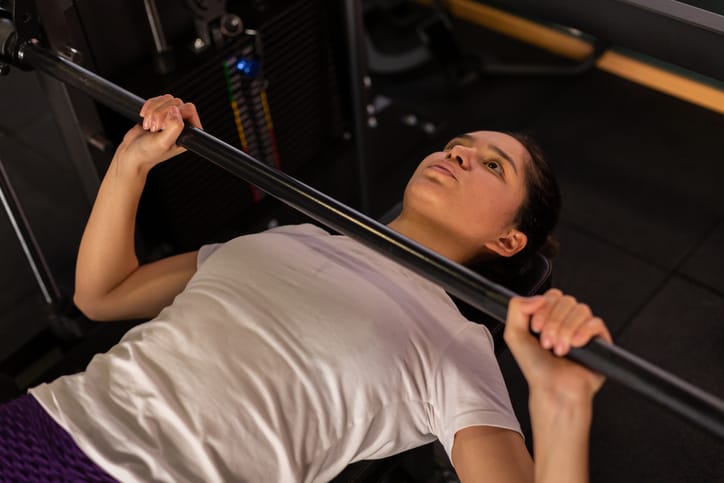The Yips

Last Wednesday's lifting session was rough. I balked on the top weight in my deadlifts: a weight I'd easily lifted for 3 sets of 3 reps the week before wouldn't budge more than an inch from the floor. I tried to calm down and reset; I tried again, and managed to pull the barbell up once, but then I dropped it. And then, I sort of spiraled mentally. I skipped my second main lift altogether (Pendlay rows, which I hate). "Fuck it," I said. I didn’t do one of my accessory lifts either, not, in this case, because the lift was too hard or the weight was too heavy but because walking over to the rack to grab the right size kettlebell was going to take a level of effort I just couldn’t muster. "Fuck it" again.
I've been lifting long enough that I can troubleshoot a lot of what went wrong: I'm nearing the peak of my half marathon training, and as I'm coming back from injury, it's even more of a strain on my body. I am tired. My hamstrings, key muscles used in the deadlift, were sore from my long run and my easy run in the few days before lifting. ("Easy" ha — I ran those damn Central Park hills both days.) I was hungry too — I probably haven't adequately adjusted my food intake to compensate for the extra miles I'm now running. And while I do keep snacks in my gym bag for just this sort of occasion, the "energy bar" I had was too little too late.
But I don't think the problem was entirely physiological. I'm struggling psychologically too, and I think that plays out not just in my mind but in my body, in my "performance."
"We Still Don't Understand the Yips," Megan Armstrong wrote last year in an article in Esquire exploring performance anxiety and failure. While anxiety and failure are surely part of everyone’s experience in sports, "the yips," she argued, "are a whole other beast."
The phrase is believed to have been coined by golfer Tommy Armour in the 1920s. In 2014, The New Yorker cited Armour as once describing the yips as “a brain spasm.” The condition is mostly attributed to baseball players and golfers when they lose the ability to perform fundamental functions of their craft, like pitching or putting. The yips, however, have always permeated the psyche of athletes in various sports — as well as people in various walks of life, such as surgeons and public speakers. In recent years, the term has fully worked its way into the casual sports lexicon.
It’s certainly worked its way into mine. There have been several occasions where, in the margins of my training journal I've jotted down the word "yips" to explain why a lift didn't go as planned. It’s shorthand for a failure that feels more mental than physical. Sometimes the ol’ "lizard brain" just refuses to move a heavy weight – a primal act of self-preservation, a little voice in your head when you un-rack the barbell that says, "you're going to be squashed when you squat. You'll never stand back up again." Sometimes you can ignore that voice; sometimes you can't. That’s what I mean, most of the time, when I say I’ve got the yips. The weight was heavy and my brain simply refused to engage my body in lifting, pushing, pulling it up and down.
That’s not exactly what the term means to the athletes and coaches that Armstrong interviews. (Although to be clear, many teams refuse to even utter the word.) And certainly the stakes are much higher for professional athletes than they are for me when a skill that they can do unthinkingly, perfectly in practice becomes impossible to achieve in a game. Me, I’m not good enough, some might argue, for my failures to be the yips. They’re just, um, failures.
There has been much more attention lately paid to the mental health of athletes, with stars like Simone Biles, Michael Phelps, and Naomi Osaka talking openly about their struggles. But according to Dr. David Grand, one of the clinicians Armstrong interviews in her article, much of this discussion has separated “mental health” from “neurophysiological health.” He believes that the yips are bound up in trauma: “the yips are a form of dissociative freeze” that are connected to traumatic experiences.
That lizard brain is there to protect you from getting hurt physically, sure. But it’s also there to protect you from getting hurt emotionally.
Social media, many of the therapists and coaches Armstrong talks to agree, radically amplifies the experience of failure for athletes. The constant barrage of “armchair quarterback” commentary. The memes. The mocking. The death threats.
I wonder how all manner of technologies – social technologies and fitness technologies – are heightening this scrutiny. Scrutinizing others. Scrutinizing ourselves. Being scrutinized by others. Being scrutinized by the machine. And to what end – particularly if some of these sports psychologists are right and the yips are bound up in feelings of embarrassment and shame, are bound up in the traumas that all of us experience, particularly when it comes to our bodies.
Historian of psychology Alexandra Rutherford uses the word “psycho-technologies” to describe B. F. Skinner’s gadgets: the teaching machine, the air crib, the “Skinner box” – all items you can read more about in my book Teaching Machines. These objects both exemplified and enacted Skinner’s psychological theory of behaviorism and its associated practice of operant conditioning. These psycho-technologies were designed to shape behavior. And while behaviorism has fallen out of favor, I’d argue that its influence remains in many of our digital gadgets today.
Fitness technologies are psycho-technologies; but the psychological model they’re using, much like their model for health and fitness itself, is ridiculously simplistic. Many of these psycho-technologies are simply attuned to “motivate” -- their goal is to get people to move more and move faster.
They cajole. They reward. But (unlike Skinner's belief – bless his heart – in exclusively positive behavior reinforcement) they also shame. They punish. And so I wonder, do they encourage the yips?
I can troubleshoot what went wrong at the gym on Wednesday. I can troubleshoot why I’m having trouble getting back to the pace and distance I was running before my “accident.” I have a whole list of physiological reasons why the barbell’s not moving, why my legs are moving. My age. My training. My knee. My glutes. My diet. My sleep.
But I'm starting to recognize – really recognize – some significant psychological reasons too. My trauma. My trauma. My trauma. Not just my fall, but all the trauma that I've experienced in the last few years, last few decades. I've funneled a lot of my hopes for "mental health" into the rhythms of exercise and movement, and it's an incredibly fragile routine.
There are times when I know my body loves it. And there are times when my brain certainly does too. But there are other times, particularly when I get the yips (which, for the record don't always look like failing at a deadlift; it can be something that happens all the time, like failing to lean forward as I run) that I'm starting to recognize now are bound up in fear and shame.
I don't think any amount of "tracking" or "optimization" with gadgets is going to address this issue. For me or for others. Indeed, what if we're just making things worse?
Thanks for reading Second Breakfast. Please consider becoming a paid subscriber. It means a lot that people still want to read my work, even though it's not about ed-tech any longer and I still have the gall to invoke Skinner.





